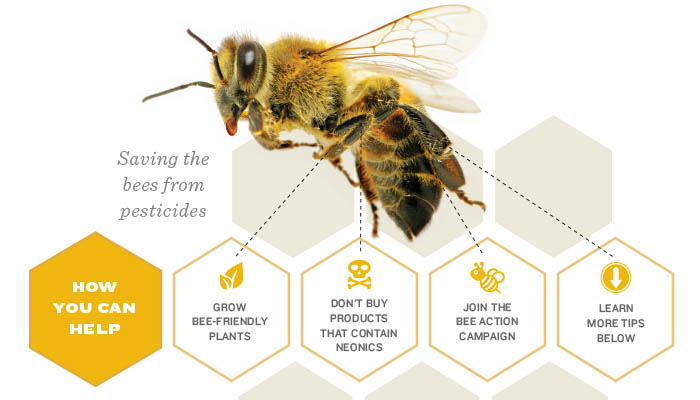By planting a bee garden you can create a habitat corridor with. There are thousands of bee species in North America that nest alone and these are often on the endangered list.
 6 Easy Things To Do To Help Bees In Your Backyard Simplemost
6 Easy Things To Do To Help Bees In Your Backyard Simplemost
Bees dont have any use for that perfectly manicured sea of St.

How to help bees. Try to let your lawn grow a little longer before you mow. Let Your Lawn Get Back To Its Roots. The RSPB recommends combining two tablespoons of white granulated sugar with one tablespoon of water and placing the mix in a small container like an egg cup among bees favourite flowers.
If you really want to be a bees best friend you could build them a watering hole. You can find simple instructions for building a bee bath here. You can support your local beekeeper by purchasing local honey beeswax candles and other bee products.
Plant Bee-Friendly Gardens Make your garden really bee-friendly by growing flowers and plants that bees love. Save time and money on your mowing and grow. Give bees a home.
Offer pollinators a drink. Put marbles or pebbles in a bowl add water and voila. A wildlife pond is perfect and provides far more to wildlife than just a place to quench thirst but if thats not possible a small dish of water with a few pebbles in it for ease of access will give bees and other insects a chance to drink.
Gentle Mason bees and leafcutters will set up housekeeping in houses you can buy or make. Saving the Bees How You Can Help If youre feeling adventurous start your own beehive. One of the largest threats to bees is a lack of safe habitat where they can build homes and find a variety of nutritious food sources.
During spring and summer its common to see exhausted bees on the ground looking dead or sluggish but you can help tired bees by mixing up a simple cocktail. Bees like to hang out in your lawn especially when on warm sunny afternoons. Flowers with nectar are good source of food for the bees.
Here are some easy ways to help savethebees without going full-on beekeeper. Bees need a diverse diet and like patches of flowers so they can focus on one type of flower at a time. Keep it about head-high and near sources of pollen and mud if youre trying to attract mason bees.
Plant a mix of bee-friendly seeds and grow plants fruit and veg Bees need different plants for food throughout the seasons from trees and shrubs to bulbs and grasses. Mowing kills bees and trims the flowers that feed them. Native plants are the plant species that are naturally found in your region that provide bees with the nectar and pollen that are their only food source.
Its important for bees as it is for us to have a diverse and regular food supply. If you have a garden or access to a piece of land planting native wild plant species will provide much needed food for bees. So if honey is not part of the solution to helping bees what can we do to help wild pollinators.
Help bees by starting a fundraiser to support conservation efforts. Make sure to place small twigs inside the basin so that the bees have a place to stand on while drinking. Small trees like hazel and holly help bees at different times of the year.
Put down the weed-eater. They provide great sources of nectar and pollen both food for the bees and butterflies. Put marbles or pebbles in a bowl add water and voila.
If you have decided to do something to help bees the first thing to do is plant the right flowers. Sign up to start your fundraiser today and see how you can make a difference. You can also sponsor a hive to help fund new hive installations though organizations like The Honeybee Conservancy.
Ivy is a top food in autumn. Here are six ways to help bees. Bees need water and a bee bath is a super easy project to help make sure they have fresh water when they need it.
Bees are important in ensuring the worlds agriculture supply and the health of the bee population is important to each one of us. Plant your garden with native and bee friendly plants. Plant a Bee Garden.
Dont add sugar as this is harmful and do change the water regularly to avoid mosquitoes laying their eggs there. One thing we need to try to do is redress the loss of wild habitat. Many weeds provide good sources of nectar and pollen so bumblebees and other native bees may be foraging underfoot.
Support local beekeepers by buying local honey and local produce. Bees get thirsty just like us. In fact some native bees are plant specialists and can only feed their larvae the pollen from specific native plants.
It is best to select native species of flowering plants so that bees can have a. Bees and other pollinators can get thirsty. Because of their importance to our food crops it is more crucial than ever to support these little buzzing beauties.
Place the house in a spot that gets warm morning sun and some afternoon shade if you live in a hot climate. Plant flowering plants which bees love. Change the water in your basin every 1-4 days.
There are certain flowers that bees find irresistible and that encourage the bees to come and collect the pollen. Here are a few easy ways you can help BeeTheSolution. Buy local and organic.
Pesticides are one of the main issues affecting bees so by. Bees are essential to the survival of many ecosystems and to humans. Bird baths also work for providing the bees with a drink.
